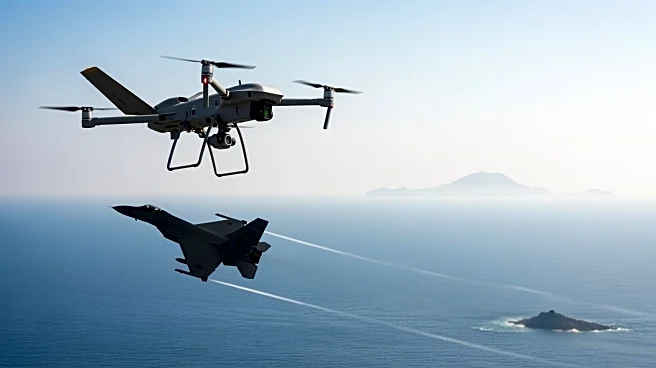What's Happening?
The Philippine Coast Guard has released video footage showing a Chinese fighter jet harassing one of its patrol aircraft near the disputed Second Thomas Shoal in the South China Sea. This incident is part of a series of tense encounters between Chinese and
Philippine forces. The footage, shared by Philippine Coast Guard spokesperson Jay Tarriela, shows a Chinese Shenyang J-16 fighter jet flying close to a Philippine patrol plane conducting a surveillance mission near Scarborough Shoal. Tarriela stated that the Chinese jet was deployed to 'harass and endanger the safe flight path' of the Philippine aircraft. Additionally, a Chinese People’s Liberation Army Navy helicopter conducted a low-altitude pass beneath the Philippine aircraft, seemingly to disrupt its mission. The Philippine Coast Guard remains committed to upholding international law and safeguarding maritime jurisdiction in the West Philippine Sea.
Why It's Important?
The South China Sea is a vital waterway for global maritime trade, and Beijing's claims over nearly the entire area have been a point of contention. The ongoing standoff between China and the Philippines, a U.S. treaty ally, has drawn in Washington, which has reiterated its commitment to the Mutual Defense Treaty with Manila. This treaty extends to any armed attack in the South China Sea, highlighting the potential for increased military involvement by the U.S. The situation underscores the geopolitical tensions in the region, with China's increased military presence around Scarborough Shoal signaling a shift toward a more militarized posture. The U.S. State Department has condemned China's actions, emphasizing the threat to regional stability.
What's Next?
The release of the video and the ongoing confrontations may lead to further diplomatic protests from Manila and Washington. The U.S. has reaffirmed its support for the Philippines, which could result in increased military cooperation or presence in the region. China's actions, including the declaration of a 'marine nature reserve' and the deployment of water cannons against Philippine vessels, may provoke further international scrutiny and pressure. The situation remains volatile, with potential for escalation if diplomatic efforts do not resolve the territorial disputes.
Beyond the Headlines
The aggressive actions by China in the South China Sea raise ethical and legal questions about sovereignty and international law. The Philippines' commitment to upholding international law contrasts with China's dismissal of the 2016 Hague ruling. The militarization of the region could have long-term implications for international maritime law and the balance of power in Southeast Asia. The situation also highlights the strategic importance of the South China Sea, not only for regional players but for global trade and security.















